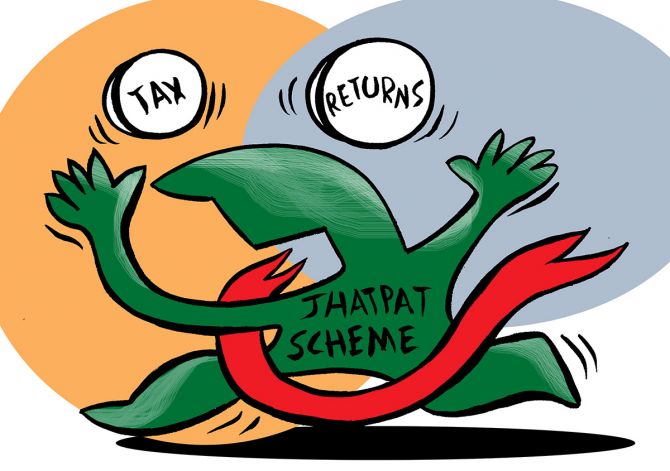The tax department will remain a source of endless nightmares for citizens and ‘transparent taxation’ will remain an empty slogan and a cruel joke, observes Debashis Basu.
In August 2020, the prime minister announced three structural tax reforms under ‘transparent taxation’ — faceless assessment, faceless appeal, and a taxpayers’ charter.
On the ground, though, maddeningly complicated income-tax rules and laws, a broken online filing system, and malfunctioning faceless tax assessments have turned this slogan into a joke.
It all starts with the torture of having to file everything online through a portal that is broken.
According to chartered accountants, the Web site has issues from logging in to filing forms and even wrong refunds.
A return filed and verified can appear as ‘unverified’ later.
In some cases, it was not possible to download the ITR, acknowledgement, or Form 10-IE even a week after filing.
Several forms require repeated attempts and what CAs call ‘tech jugaad‘ to get the system to accept them.
There are mismatches galore. New assessees and digital signatures are not accepted and even a one-time password for Aadhaar-enabled verification often does not work.
This ordeal, which started last June, reached a crescendo approaching December 31, which was the last date for filing tax returns by individuals for the financial year ended 2020-21.
Tax practitioners, most of them big supporters of the current regime, took to social media to voice their anger and frustration over the disastrous tax portal.
The response from a punitive State was expectedly callous and dismissive.
The revenue secretary insisted that the site was working perfectly, citing the number of returns filed.
Remember, in the middle of a raging second wave, the government had launched a new online tax-filing portal, for which it paid Infosys hundreds of crores.
Tax practitioners say there was no need for a new portal.
The earlier one worked fine despite bugs in some forms and utilities, which were either fixed or could be worked around.
Filing anything on the new portal is “now akin to running a marathon obstacle race while a hurricane is raging all around you”, said CA Ameet Patel.
When users started complaining, the government, as usual, ignored them.
After all, the prime minister has signalled that anyone raising questions about a government initiative has a ‘negative mindset’.
When the complaints seem never-ending and also emanated from associations of tax practitioners, there was a token public admonishment of Infosys by the prime minister.
In late August 2021, Infosys had promised that the glitches would be fixed ‘in a few days’.
And yet, on January 8, 2022, CAs were driven to sending the finance minister a long list of maddening issues they were being forced to deal with every day.
A thorough testing before the launch, and continuous debugging through feedback after the launch, are the cornerstones of any software development.
Amazingly, a tech-savvy government, which has Digital India as one of its missions, didn’t do this adequately.
Remember Aadhaar and goods and services tax were launched with the same attitude — no need to test or bother about feedback.
Another important aspect of any project is the fallback option.
It is not uncommon in software projects to roll back to the previous version if the latest one is too buggy.
Unbelievable but true, the old IT portal has been scrapped.
It is not possible to go back to it, even temporarily.
A government that prides itself on planning and implementation had no Plan B in case the new portal had hiccups!
Would Infosys have delivered such a glitch-ridden platform to any of its private sector clients? And would it have been accepted without adequate testing? Far from turning the screws, the government remains as cosy with Infosys as before.
Remember, Infosys is also the creator of another malfunctioning government portal — MCA21, for corporate filings.
Indeed, it is a big mystery why a government that is acutely conscious of its public image and is brutal with its citizens and organisations for any lapses, is handling a private company with kid gloves, even despite delivering broken projects.
Is it because someone in government has signed off on verification, testing, and acceptance of the glitchy projects?
Faceless assessments
Everyone had believed that faceless assessments would end corruption.
Indeed, many assessments were completed quickly and refunds issued in record time; in other cases, assessees are having a nightmare: Orders generated with wildly large additions or disallowances, not granting adequate time, not giving an opportunity to present one’s arguments, notices sent to wrong email IDs.
The faceless assessment was also not thought through.
According to Ameet, a lot of work has come to a halt, such as appeals.
Notices are being issued by the ‘system’, asking for the same information again and again.
Even if someone provides his response by selecting the ‘Final’ tab and not the ‘Partial’ tab, the appeal is not disposed of.
Another notice arrives after a few months.
CAs also complain of mistakes in demand orders not being rectified; at the same time, the inflated demand is adjusted automatically by the ‘system’ against refunds due.
Even when appeals go in favour of taxpayers, demands continue to be adjusted against refunds.
Most applications for rectifying mistakes are lying unattended.
There is no clarity on who has the jurisdiction to deal with them — the Central Processing Centre (or the jurisdictional officer.
Last year, the government had started tax reassessments well after the deadline.
This has now been struck down by the court.
Tax forms themselves are maddeningly complicated and getting longer, while the law is punitive even for minor lapses.
The fact is, tax torture and taxtortion are built into the system.
Hence, the tax department will remain a source of endless nightmares for citizens and transparent taxation’ will remain an empty slogan and a cruel joke.
Debashis Basu is the editor of moneylife.in
Feature Presentation: Aslam Hunani/Rediff.com
Source: Read Full Article


